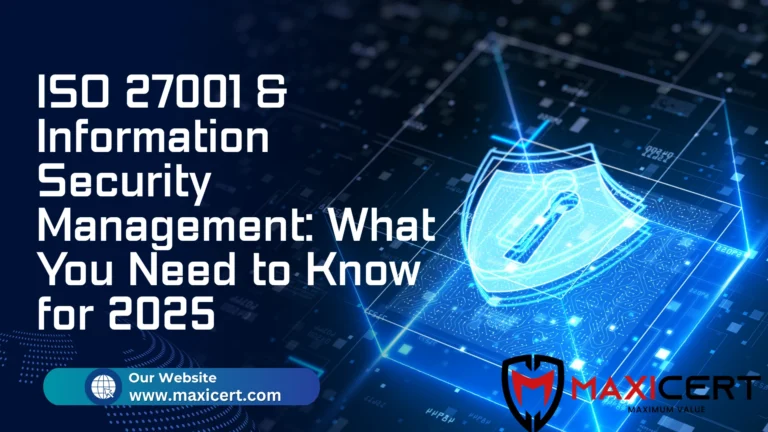ISO 27001 & Information Security Management: What You Need to Know for 2025

Introduction
In the digital age we live in, protecting sensitive information is no longer a choice, but a necessity. Businesses face a multitude of challenges in the form of increasing cyber threats, data breaches, and regulatory requirements which makes protecting sensitive information a business asset imperative. The globally accepted standard for Information Security Management Systems (ISMS) ISO 27001 provides a structured, risk based approach to managing information security. It aids organizations of any size and industry in protecting the confidentiality, integrity and availability of their data, be it financial records, customer details, or intellectual property.
In this blog, I will be exploring the most important principles of ISO 27001, its role in the establishment of a solid security framework, and its aid to organizations in demonstrating trust, compliance, and resilience amidst rapidly changing threats.
What is ISO 27001?
ISO 27001 is an international standard issued by the International Organization for Standardization (ISO) and the International Electrotechnical Commission (IEC). It sets the criteria for the establishment, implementation, maintenance, and continuance improvement of an Information Security Management System (ISMS).
An ISMS is an organized method of managing sensitive corporate information so that it stays safe. It encompasses personnel, processes, and information technology systems.
Know More About ISO 27001.
Request A Free Quote
Why ISO 27001 Matters in 2025
The need for strong information security measures is increasingly critical as we delve further into a digital world. With 2025 approaching, understanding the relevance of ISO 27001 is essential. Here’s why:
1. Escalating Cybersecurity Attacks
Data breaches, ransomware, and cyber attacks more generally have become more sophisticated and prevalent. Businesses of any size and in any industry, face a serious systemic risk. With ISO 27001 it is possible to:
- Proactively and strategically defend against cyber attackers.
- Safeguard sensitive information, including customer data, financial records, and intellectual property.
- Systematic controls and risk assessments help in mitigating risks.
2. Intensifying Global Regulatory Framework
The rise of organizations such as NCA in Saudi Arabia, GDPR, and CCPA, just to name a few, have introduced new regulatory frameworks with more powerful data protection policies. With ISO 27001 organizations can:
- Stay in norms and avoid both local and international compliance issues.
- Ensure compliance to avoid penalties and reputational damage.
- Maintain a suitable structure for compliance and supports continual legal adherence.
3. Dependency on Cloud And Remote Work
The rise of cloud computing and adoption of hybrid and remote work models have increased the flow of data across multipe environments. ISO 27001:
- Maintains remote access and third party vendor safeguards.
- Secures cloud infrastructures and online collaboration.
- Addresses modern threats for remote working.
4. Consumer Confidence and Industry Competition
Customer stakeholders expect business organizations to demonstrate their data management practices. With ISO 27001 certification:
- Enhances trust and reputation with customers.
- Provides a unique differentiator in local and international business tenders.
- Provides access in sectors such as finance, medicine, and IT services.
5. Helps Achieve Goals for Digital Transformation
The ISO 27001 standard integrates perfectly with digital transformation initiatives. It:
- Facilitates automation in the security process.
- Provides for a risk-managed strategy to innovation.
- Makes certain data security is considered at all levels of the digital evolution.
Who Requires ISO 27001?
ISO 27001 is suitable for any organization that deals with confidential information. Some key sectors include:
- Finance & Banking
- Healthcare
- Information Technology & Cloud Services
- Government & Defense
- E-commerce
- Telecommunication
The standard also benefits small and medium-sized enterprises (SMEs), particularly those collaborating with larger companies that seek third-party verification.
Fundamental aspects of ISO 27001
The ISO 27001 standard revolves around the establishment, implementation, and continuous refinement of an Information Security Management System (ISMS). Below are the basic components which are foundational to this standard:
1. Information Security Policies
- These are official documents outlining how an entity manages concerns around information security.
- These documents are strategic and help shape risk management and mitigation activities.
2. Risk Assessment and Risk Treatment
- Identify potential risks and impacts, along with vulnerabilities associated with the assets.
- Evaluate the risk and determine how to manage it — accept, mitigate, transfer, or avoid.
- Document a Risk Treatment Plan which aligns with organizational objectives.
3. Leadership and Commitment
- The ISMS requires active participation from the organization’s top management.
- Allocate tasks and responsibilities, while also ensuring sufficient support.
- Build an environment of constant security vigilance and responsibility.
4. Asset Management
- Use the company information assets to embrace innovate technologies like software and data.
- Establish guidelines and actionable steps to enforce ownership and protective measures.
5. Access Control
- Safeguard confidential business information by ensuring only authorized personnel have access.
- Ensure strong password controls, account verification, and privilege access controls are in place.
6. Physical and Environmental Security
- Protect facilities, data centers, and equipment from theft, fire, and other disasters.
- Utilize secure zones, monitoring, and access control.
7. Operations Security
- Protect the processes and information through documented policies and procedures.
- Control backups and logging; monitor systems and malware defenses.
8. Communication and Cryptographic Controls
- Safeguard information from unauthorized access.
- Implement encryption, secure messaging, and VPNs where necessary.
9. Supplier Relationships
- Evaluate and assess information security of the third party vendors and contractors.
- Add provisions to the contract to ensure adherence to ISMS policies and documented procedures.
10. Incident Management
- Establish procedures for identifying, reporting, and responding to security incidents.
- Establish and maintain an incident response plan while logging all associated activities for post-event review and continuous improvement.
11. Business Continuity Management
- Embed information security requirements within the business continuity plans.
- Safeguard the ability for critical functions to be performed during and after an adverse incident.
12. Compliance and Legal Requirements
- Outline and consider as minimum all applicable legal, statutory, regulatory, and contractual obligations.
- Track and evaluate compliance regularly through audits.
13. Internal Audits and Continual Improvement
- Maintain an internal audit schedule to evaluate the effectiveness of the ISMS.
- Use the results of the audits to implement corrective measures and foster continuous enhancement.
ISO 27001 Implementation Process: Step-by-Step Guide
Although the process of implementing ISO 27001 may appear daunting, having a well-defined roadmap accelerates certification and enhances data protection. Presented below is an actionable process for implementing ISO 27001.
1. Obtain Top Management Commitment
- Get leadership to commit to resource allocation and support for the ISMS project and to define its scope.
- Highlight the advantages of implementation: meeting legal obligations, minimizing risks, and enhanced customer confidence.
2. Define the Scope of the ISMS
- Choose the sections of your organization which will fall under the ISMS.
- Think about physical locations, departments, assets, and even third parties.
3. Establish an ISMS Policy
- Create a policy that sets objectives, assigns information security roles, and defines strategic goals.
4. Conduct a Risk Assessment
- Identify relevant assets, possible threats, vulnerabilities, and determine possible impacts.
- Assess the estimated risk after determining the likelihood and consequences.
5. Develop a Risk Treatment Plan
- Determine how to handle specific risks: to mitigate, avoid, accept, or transfer.
- Choose relevant controls from Annex A of ISO 27001.
6. Implement Controls and Mitigation Measures
- Integrate the information security risk management processes into the ISMS framework to alleviate those risks.
- Implementation measures: firewalls, access restrictions, security training, information systems security, data encryption, among others.
7. Develop Supporting Documentation
- Create necessary documentation like:
- Information Security Policy
- Risk Assessment Methodology
- Statement of Applicability (SoA)
- Asset Inventory
- Access Control Policy
- Incident Response Play
8. Train and Raise Awareness
- Train employees on security measures and the essential role they play in safeguarding sensitive data.
- Hold information sessions, awareness initiatives, training sessions, and periodic workshops.
9. Monitor, Audit & Review
- Conduct internal audits to assess the ISMS performance.
- Track incidents, risks, and relevant metrics.
10. Undertake a Management Review
- Conduct regular review sessions with the management to assess and improve the ISMS.
11. Get Ready for a Certification Audit
- Select an appropriate ISO 27001 certifying body.
- Go through a two-stage audit process:
- Stage 1: Review of documentation
- Stage 2: Evaluation of Implementation and Effectiveness
12. Continual Improvements of the ISMS
- ISO 27001 cannot be implemented once and forgotten.
- Continually observe and adapt the framework to address new challenges or changes in the business environment.
Benefits of ISO 27001 Certification
- Enhances data protection and reduces the risk of suffering from cyber incidents.
- Enhances trust from clients and stakeholders by proving commitment to security compliance.
- Ensures regulatory compliance to avoid penalties and legal risk.
- Improved business continuity in conjunction with effective risk management.
- Increases competitive advantage in the domestic and and foreign markets.
- Decreased costs associated with breaches, downtime, and ukta inefficiencies.
ISO 27001 Implementation: Challenges and Solutions
| Challenge | Description | Solution |
|---|---|---|
| 1. Lack of Management Support | Difficulty in getting leadership buy-in for resource allocation and policy enforcement. | Present a strong business case showcasing ROI, risk reduction, and legal compliance; involve leadership early in the ISMS process. |
| 2. Limited In-House Expertise | Team lacks experience in ISO standards or information security frameworks. | Provide staff training; hire or consult with ISO 27001 experts to ensure correct implementation. |
| 3. Poor Risk Assessment Practices | Risks are not properly identified or analyzed, leading to ineffective controls. | Use standardized methodologies (like ISO 27005); tailor assessments to your business assets and vulnerabilities. |
| 4. Resistance to Change | Employees are reluctant to adopt new policies and security practices. | Conduct awareness programs; involve staff in planning and policy development to build ownership. |
| 5. Complex or Redundant Documentation | Overly detailed or disorganized documents confuse staff and hinder audits. | Simplify and streamline documentation; use templates and ISMS tools for consistency and clarity. |
| 6. Integration Issues with Existing Systems | Difficulty aligning ISO 27001 with current quality or IT systems (e.g., ISO 9001, ISO 20000). | Perform a gap analysis; use an integrated management system approach to avoid duplication. |
| 7. Maintaining Continuous Improvement | ISMS becomes stagnant post-certification, failing to evolve with new risks. | Schedule regular internal audits, reviews, and security updates; monitor KPIs to track ISMS performance. |
ISO 27001 vs Other Cybersecurity Standards:
| Standard | Type | Focus | Certification | Applicable Regions | Main Audience |
|---|---|---|---|---|---|
| ISO 27001 | International Standard | Information Security (ISMS) | Yes (third-party) | Global | All industries |
| NIST CSF | Voluntary Framework | Cyber Risk Management | No | Primarily U.S., globally used | Public & private sector |
| SOC 2 | Attestation Report | Data Security & Trust Services | Yes (auditor-based) | Mainly U.S., global firms | Tech & SaaS companies |
| GDPR | Legal Regulation | Data Protection & Privacy (EU) | No (mandatory compliance) | EU (global impact) | Any org handling EU personal data |
| HIPAA | Legal Regulation | Health Data Privacy (U.S.) | No (mandatory compliance) | U.S. | Healthcare sector |
How Maxicert Will Help You Get ISO 27001 Certified in Saudi Arabia
With Maxicert, achieving ISO 27001 certification becomes much simpler. We offer focused end-to-end ISO 27001 consultancy in Saudi Arabia and other countries, ensuring that our clients do not face unnecessary issues.
Here’s how Maxicert supports you at every stage:
- Readiness Check & Gap Analysis
- Support in drafting the necessary policies and other documents
- Plan and assess the associated risks
- Staff Training and Awareness Programs
- Support in Preparing and Conducting the Audit
- Coordination with Certification Body
- Maintenance After Certification
Discover our ISO certification services in the Saudi Arabia.
Conclusion
Achieving ISO 27001 certification is not merely a formality , it is a milestone toward creating a resilient organization that is conscious about security. With rising cyber attacks, demanding customers, and stricter regulations, an ISO 27001 compliant ISMS is your strategic security advantage.
For an accelerating startup or a large enterprise with several moving parts, ISO 27001 certification is vital to keeping you secure, maintaining trust, and keeping you a step ahead of the competition.
Interested in Securing Your Business?
Maxicert is your reliable partner in ISO 27001 consulting and certification, ready to help.
We encourage you to contact us today for a free consultation to start your path toward ISO 27001 certification.

Get In Touch

Get In Touch

Get In Touch
Need A Free Estimate?
Get a free consultation and Checklist to get certified for ISO , HALAL, CE Mark Certification.
FAQ
What is ISO 27001 and why is it important?
ISO 27001 is an internationally recognized standard for information security management systems. It assists organizations in ample data protection, reducing risks, and has a reference for compliance needed.
Who needs ISO 27001 certification?
Any financial, healthcare, IT, government, or telecom organization dealing with sensitive information data will find value in ISO 27001 certification.
How long does it take to get ISO 27001 certified?
With an organization’s size and complexity, their existing security practices, and the intensity of its operations; it typically takes 3-6 months.
What are the main components of an ISMS?
Some of the critical components are risk management, information security policies, information security asset management, identity and access management, security incident management and security process improvement.
How can Maxicert help with ISO 27001 certification?
Maxicert gap analysis, documentation, training, audit preparation and post certification support. Offers comprehensive ISO 27001 certification assistance from gap analysis to post-certification support.



